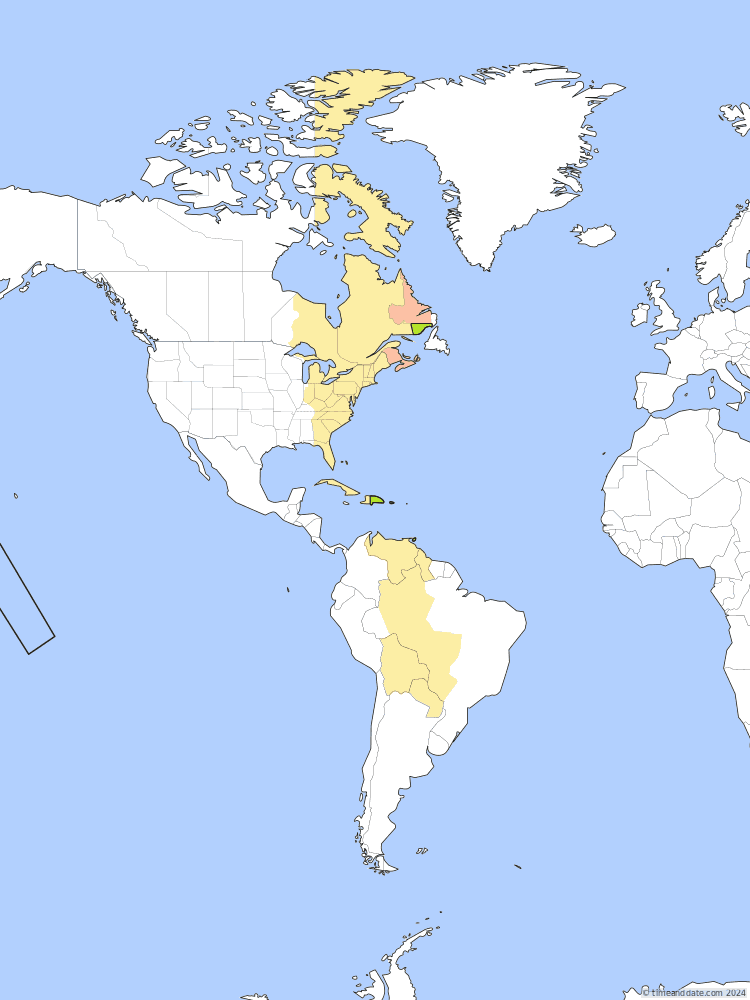Also known as: Atlantic Time (AT) and Atlantic Daylight Time (ADT)
North America: Only some locations are currently on AST because most places in this time zone are currently on summer time / daylight saving time and are observing ADT.
Atlantic: AST is currently not observed because locations are on summer time / daylight saving time and are observing ADT.

Observes AST part of the year.
Areas with same time currently (UTC -4).
Observes AST – Atlantic Standard Time part of the year, but not currently.
Currently has same time zone offset as AST (UTC -4) but different time zone name.
Atlantic Standard Time (AST) is 4 hours behind Coordinated Universal Time (UTC). This time zone is in use during standard time in: North America, Atlantic, Caribbean.
What Is Atlantic Standard Time?
Atlantic Standard Time (AST) is an eastern time zone in North America. It is used in the northeast of Canada.
It covers all or parts of four provinces in Canada, and although not used in mainland United States, the US territories Puerto Rico and the US Virgin Islands use the time zone.
In North America, Atlantic Standard Time shares a border with Eastern Standard Time (EST) in the west.
Atlantic Standard Time Zone
Atlantic Standard Time (AST) is a standard time zone in use from the first Sunday in November to the second Sunday in March—when Daylight Saving Time (DST) is not in effect. Atlantic Daylight Time (ADT) is used during the remainder of the year.
Potential New Time Zone in the US
Over the past decade, all six New England states have considered legislation to move from Eastern Standard Time to Atlantic Standard Time. This is often known as permanent DST because Eastern Daylight Time and Atlantic Standard Time have the same UTC offset: -4.
In 2019, the Governor of Delaware signed Senate Bill 73 to change the time zone to Atlantic Standard Time. The bill requires that Pennsylvania, New Jersey, and Maryland each do the same.
However, for the bills to come into effect, Congress first has to pass a federal law allowing states to observe DST year-round because today's law only allows states to forgo DST.
AST Is the Atlantic Time Zone
In everyday usage, AST is often referred to as Atlantic Time (AT) or the Atlantic Time Zone. This can add a bit of confusion as the term Atlantic Time does not differentiate between standard time and Daylight Saving Time, so Atlantic Time switches between AST and ADT in areas that use DST during part of the year.
Most North American time zones have generic terms, including Pacific Time (PT), Mountain Time (MT), Central Time (CT), and Eastern Time (ET).
Converting Atlantic Standard Time to Other US Time Zones
- Atlantic Standard Time (AST) is 1 hour ahead of Eastern Standard Time (EST).
To convert AST to EST, you have to subtract one hour. - Atlantic Standard Time (AST) is 2 hours ahead of Central Standard Time (CST).
To convert AST to CST, you have to subtract two hours. - Atlantic Standard Time (AST) is 3 hours ahead of Mountain Standard Time (MST).
To convert AST to MST, you have to subtract three hours. - Atlantic Standard Time (AST) is 4 hours ahead of Pacific Standard Time (PST).
To convert AST to PST, you have to subtract four hours.
Time Zone Converter: UTC to AST
Where and When is AST Observed?
North America
Canadian provinces using AST in the winter and ADT in the summer:
- Most of Labrador (mainland part of the province of Newfoundland and Labrador)
- New Brunswick
- Nova Scotia
- Prince Edward Island
Canadian provinces using AST all year:
Areas of Greenland using AST in the winter and ADT in the summer:
Atlantic
Caribbean
Caribbean countries/territories using AST all year:
- Anguilla
- Antigua and Barbuda
- Aruba
- Barbados
- British Virgin Islands
- Caribbean Netherlands
- Curaçao
- Dominica
- Dominican Republic
- Grenada
- Guadeloupe
- Martinique
- Montserrat
- Puerto Rico
- Saint Barthélemy
- Saint Kitts and Nevis
- Saint Lucia
- Saint Martin (FR)
- Saint Vincent and Grenadines
- Sint Maarten (NL)
- Trinidad and Tobago
- Turks and Caicos Islands
- US Virgin Islands
Other Time Zones in UTC -4
Some time zones exist that have the same offset as AST, but can be found under a different name: